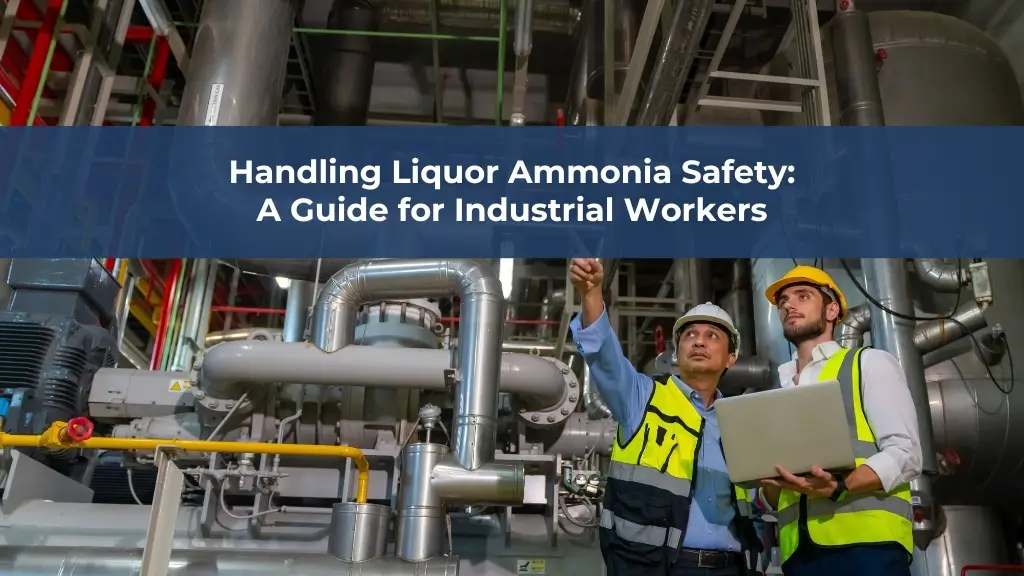Liquor ammonia, also known as ammonia solution or ammonia water, is a common chemical used in various industrial applications. It is a colorless liquid with a pungent smell and is highly soluble in water. While liquor ammonia has many uses, it is important to handle and store it with caution due to its potential risks. In this article, we will explore the basics of liquor ammonia, the safety measures for handling it, safe storage practices, and the regulatory compliance associated with its usage.
Understanding Liquor Ammonia
Liquor ammonia, chemically known as ammonium hydroxide (NH4OH), is a solution of ammonia gas dissolved in water. It is widely used in industries such as chemical manufacturing, pharmaceuticals, agricultural applications, and cleaning products. The concentration of ammonia in liquor ammonia can vary, with typical solutions containing around 10-35% ammonia by weight.
Ammonia is a compound composed of nitrogen and hydrogen atoms. When dissolved in water, it forms a solution that is commonly referred to as liquor ammonia. This versatile substance has a pungent odor and a strong alkaline nature, making it useful for various industrial applications.
The Basics of Liquor Ammonia
Liquor ammonia is an alkaline substance and has a wide range of applications. It is commonly used as a cleaning agent due to its ability to break down grease and remove stains. It is also utilized in the production of fertilizers, dyes, and pharmaceuticals.
In the agricultural sector, liquor ammonia is often used as a source of nitrogen for plants. It can be applied directly to the soil or sprayed on crops to promote growth and increase yield. Additionally, in the pharmaceutical industry, liquor ammonia plays a crucial role in the synthesis of various drugs and medications.
Potential Risks of Liquor Ammonia
Although liquor ammonia has many beneficial uses, it is essential to recognize and mitigate the associated risks. The primary risk is its corrosive nature, which can cause severe burns if it comes into contact with the skin or eyes. Inhalation of ammonia fumes can irritate the respiratory system and lead to respiratory distress. Additionally, when exposed to heat or flames, liquor ammonia can release toxic fumes.
Proper handling and storage of liquor ammonia are crucial to ensure the safety of workers and the surrounding environment. Protective gear, such as gloves, goggles, and respiratory masks, should be worn when working with this substance. In case of accidental exposure, immediate medical attention is necessary to prevent further complications.
Safety Measures for Handling Liquor Ammonia
When handling liquor ammonia, it is crucial to follow strict safety protocols to minimize the risk of accidents or injuries. The use of personal protective equipment (PPE), safe handling techniques, and awareness of emergency response procedures are vital for ensuring the safety of workers and the surrounding environment.
Personal Protective Equipment (PPE)
Wearing the appropriate PPE is crucial when working with liquor ammonia. This includes goggles or a face shield to protect the eyes, chemical-resistant gloves to safeguard the hands, and a chemical-resistant apron or suit to shield the body from potential splashes or spills. In addition to PPE, it is essential to have access to emergency eyewashes and safety showers in case of accidental exposure.
Safe Handling Techniques
Proper training on safe handling techniques is necessary for anyone working with liquor ammonia. It is important to only handle the chemical in well-ventilated areas to minimize the risk of inhalation. Liquor ammonia should be stored and transported in approved containers, ensuring that they are tightly sealed to prevent leaks. It is also essential to avoid mixing liquor ammonia with incompatible substances, such as acids or oxidizers, as this can generate hazardous reactions.
Emergency Response Procedures
In the event of an accidental release or exposure to liquor ammonia, it is crucial to have clear emergency response procedures in place. Workers should be familiar with the location of emergency exits, emergency shutdown procedures, and how to contact emergency services. Regular drills and training exercises can help ensure that everyone is prepared to respond quickly and effectively in an emergency situation.
Furthermore, it is important to establish a designated area for the storage and handling of liquor ammonia. This area should be well-ventilated and equipped with proper ventilation systems to prevent the accumulation of hazardous fumes. Regular inspections and maintenance of these systems are necessary to ensure their effectiveness.
Additionally, it is crucial to regularly monitor the concentration of liquor ammonia in the workplace to ensure that it remains within safe limits. This can be done through the use of gas detectors or by conducting air sampling tests. By regularly monitoring the concentration levels, potential risks can be identified and addressed promptly, minimizing the likelihood of accidents or exposure.
Moreover, proper waste management procedures should be implemented when dealing with liquor ammonia. Any spills or leaks should be promptly cleaned up using absorbent materials and disposed of in accordance with local regulations. It is important to avoid flushing liquor ammonia down drains or disposing of it in regular trash bins, as this can lead to environmental contamination.
Lastly, ongoing training and education programs should be provided to all personnel working with liquor ammonia. This includes regular refresher courses on safety protocols, emergency response procedures, and the proper use of PPE. By keeping employees well-informed and up-to-date on best practices, the risk of accidents or injuries can be significantly reduced.
Safe Storage of Liquor Ammonia
Proper storage of liquor ammonia is essential to minimize the risks associated with its handling and ensure its longevity. Adhering to specific storage guidelines and using the appropriate safety equipment can prevent accidents and maintain the integrity of the chemical.
### Ideal Storage Conditions
Liquor ammonia should be stored in a well-ventilated area away from direct sunlight and sources of heat. It should be kept in a cool, dry place with a stable temperature. Ideally, storage areas should be equipped with temperature and humidity controls to maintain optimal conditions. These measures help reduce the risk of evaporation or degradation of the chemical.
When considering the ideal storage conditions for liquor ammonia, it is important to note that the chemical is highly reactive and can release toxic fumes if exposed to certain substances. Therefore, it is crucial to store liquor ammonia away from incompatible materials such as acids, oxidizers, and flammable substances. This not only ensures the safety of the storage area but also prevents any potential reactions that could compromise the integrity of the chemical.
Storage Safety Equipment
Special safety equipment is necessary when storing liquor ammonia. This includes chemical-resistant storage tanks or containers designed specifically for ammonia solutions. These containers should be constructed of materials that can withstand the corrosive nature of liquor ammonia. They should also be properly labeled with clear markings indicating the contents and associated hazards.
In addition to the appropriate containers, it is essential to have proper ventilation systems in place to prevent the buildup of ammonia vapors. Ventilation helps maintain a safe working environment by removing any potential fumes or gases that may be released during storage or handling. It is important to regularly inspect and maintain these ventilation systems to ensure their effectiveness.
Long-term Storage Considerations
Long-term storage of liquor ammonia requires additional precautions. Regular inspections should be conducted to ensure that storage containers remain in good condition and free from leaks. It is important to monitor the ammonia concentration periodically to ensure that it remains within the desired range. Proper record-keeping of storage conditions, including temperature, humidity, and maintenance activities, is essential to ensure compliance with regulatory requirements and to facilitate effective inventory management.
Furthermore, it is crucial to have a well-defined emergency response plan in place in case of accidental spills or releases. This plan should include procedures for containing and neutralizing the ammonia, as well as guidelines for notifying the appropriate authorities and personnel. Regular training and drills should be conducted to ensure that all individuals involved in the storage and handling of liquor ammonia are familiar with the emergency response protocols.
By following these guidelines and implementing the necessary safety measures, the storage of liquor ammonia can be effectively managed, minimizing the risks associated with its handling and ensuring the safety of personnel and the surrounding environment.
Regulatory Compliance for Liquor Ammonia
There are various regulatory standards and guidelines that govern the handling and storage of liquor ammonia. Compliance with these regulations is necessary to minimize risks to workers, the environment, and the public.
Understanding Regulatory Standards
It is crucial to familiarize oneself with the applicable regulatory standards for handling and storing liquor ammonia. These standards may vary depending on the region or industry. Common regulations cover aspects such as storage requirements, training and competency of personnel, emergency response planning, and record-keeping.
Compliance Checklist
To ensure compliance, organizations should develop a compliance checklist specific to their operations. This checklist should outline the necessary steps and requirements to meet regulatory standards. Regular audits and inspections can be conducted to confirm compliance and identify any areas for improvement. Maintaining accurate documentation of these compliance activities is important for both internal and external audits.
Regular Safety Audits and Inspections
Regular safety audits and inspections help identify and rectify potential safety hazards or compliance gaps. These audits should be carried out by qualified individuals with a thorough understanding of liquor ammonia handling and storage requirements. The findings and recommendations from audits should be documented, and corrective actions should be taken promptly to address any identified deficiencies.
Conclusion
In conclusion, safety precautions for handling and storing liquor ammonia are vital to prevent accidents, injuries, and environmental hazards. Understanding the basics of liquor ammonia, implementing appropriate safety measures, practicing safe handling techniques, and adhering to regulatory compliance can significantly mitigate the risks associated with this chemical. By prioritizing safety and following these precautions, organizations can create a safe working environment for employees and minimize the impact on the surrounding community.













